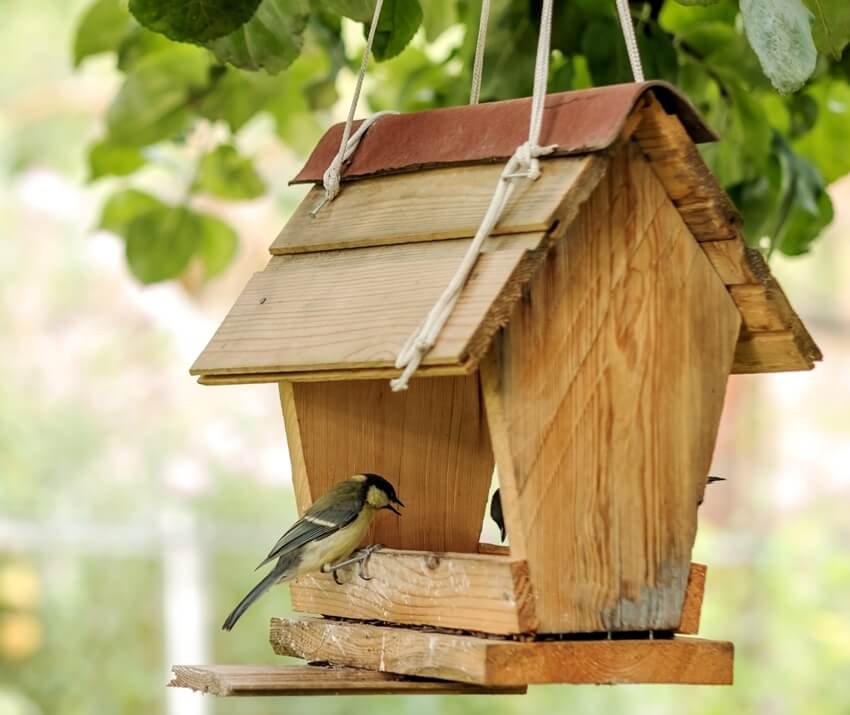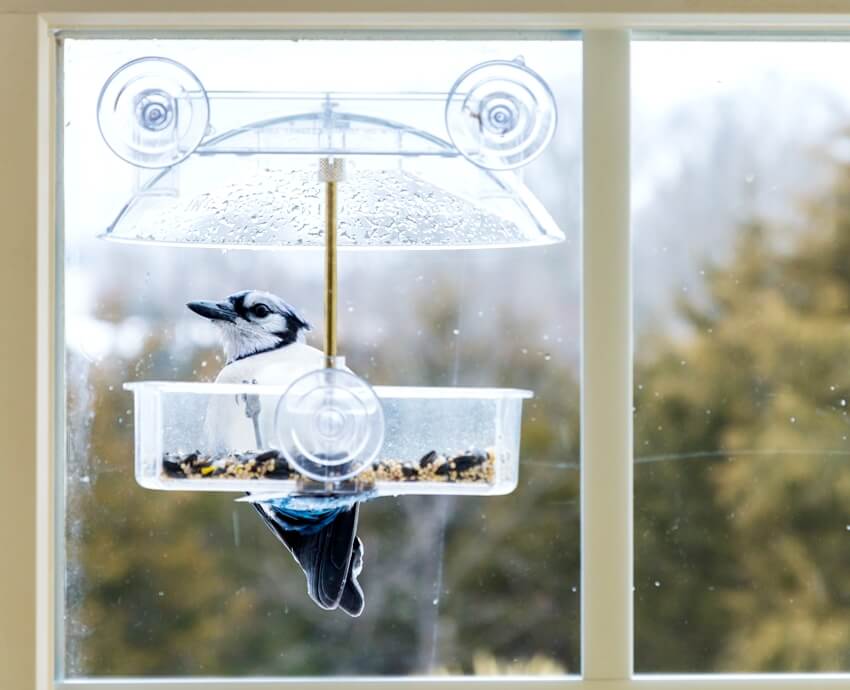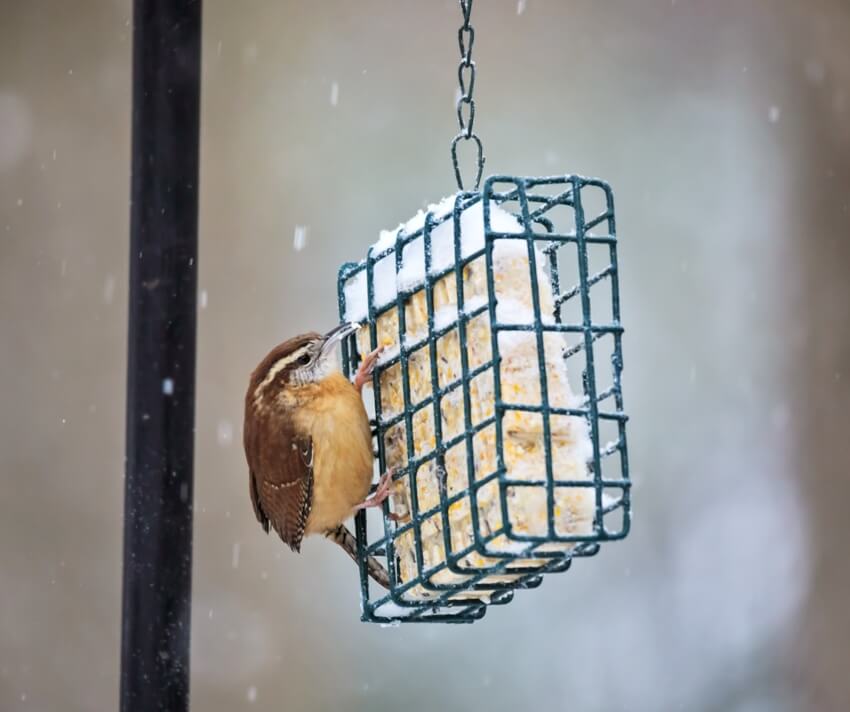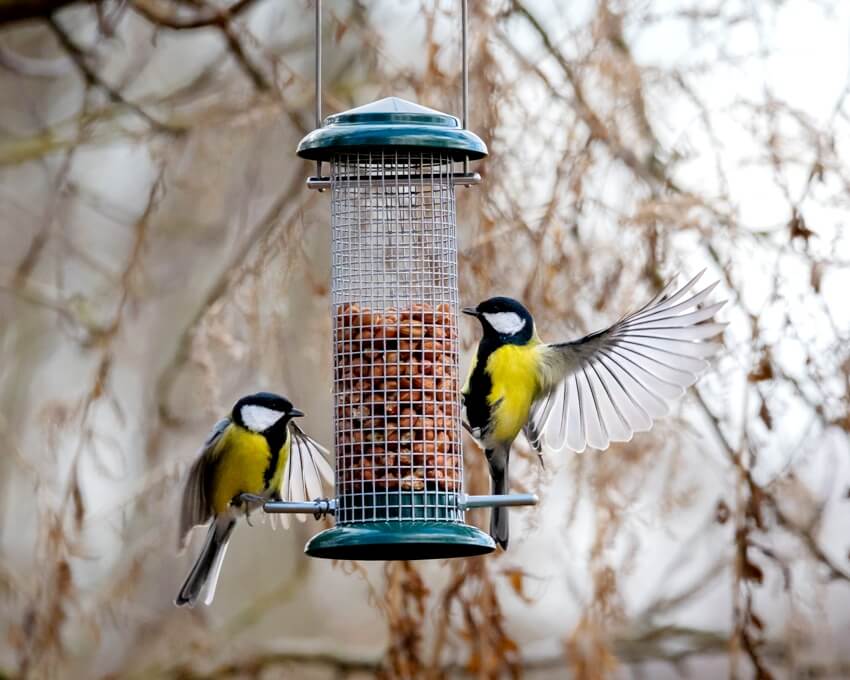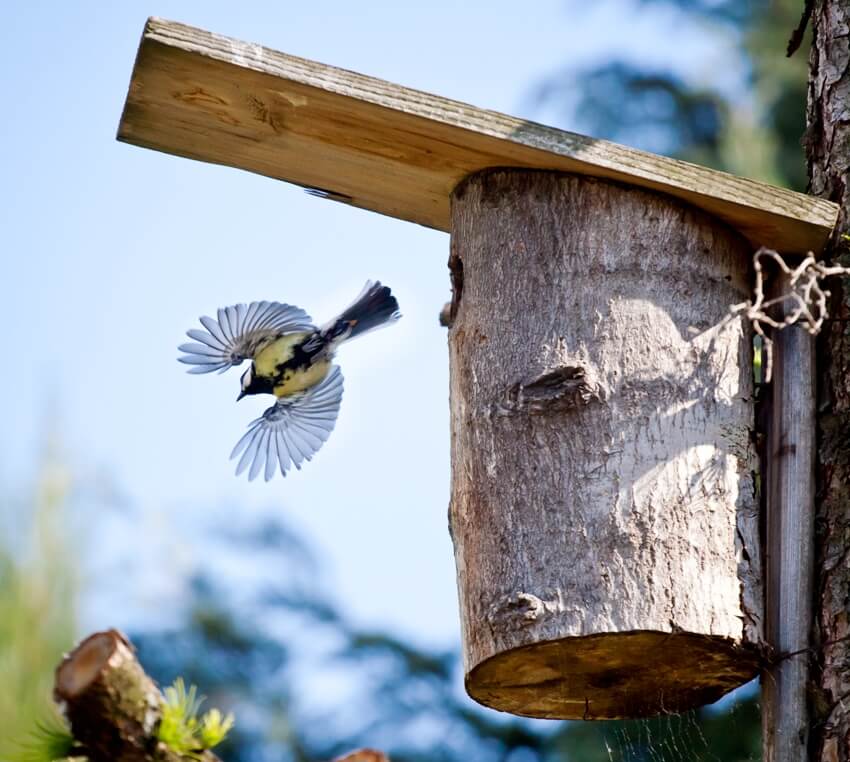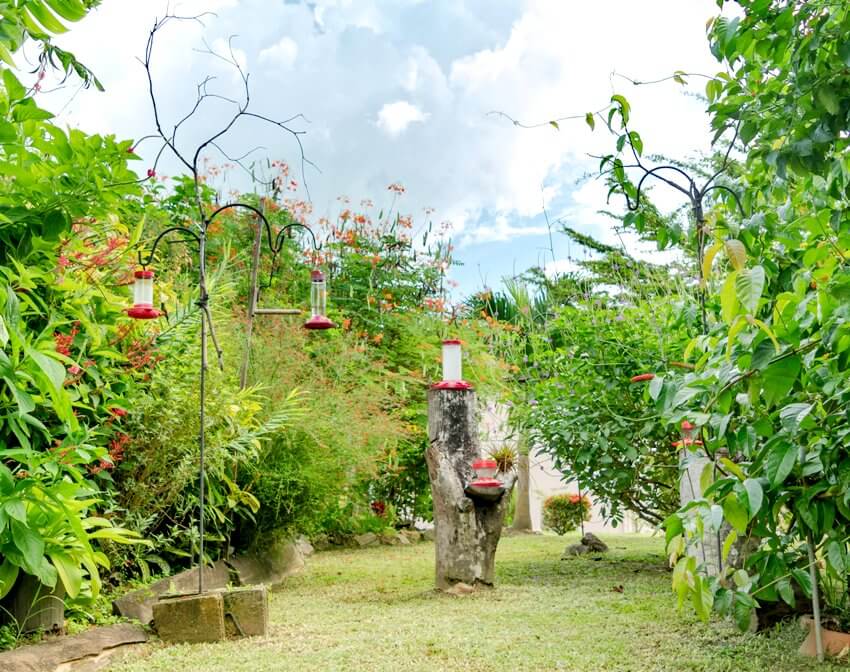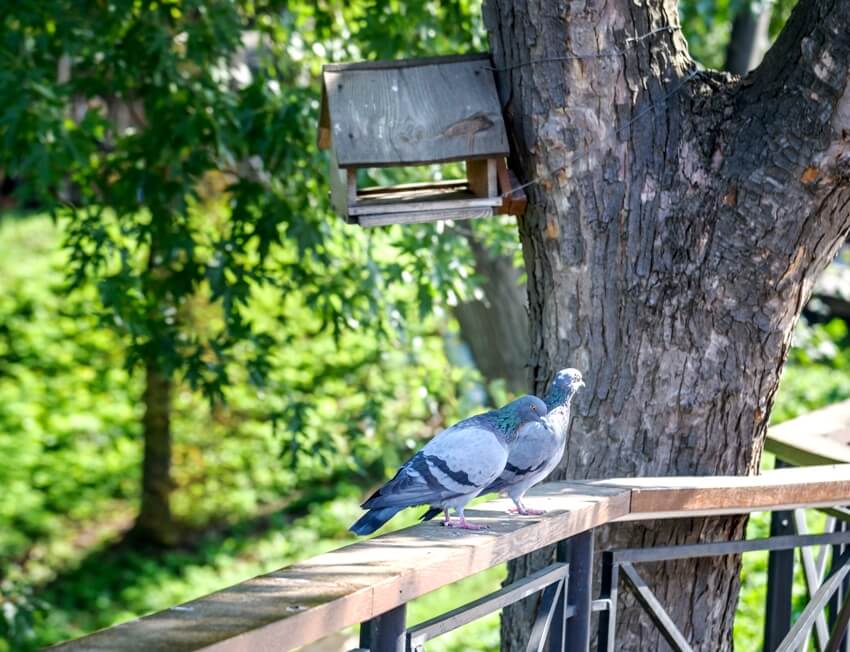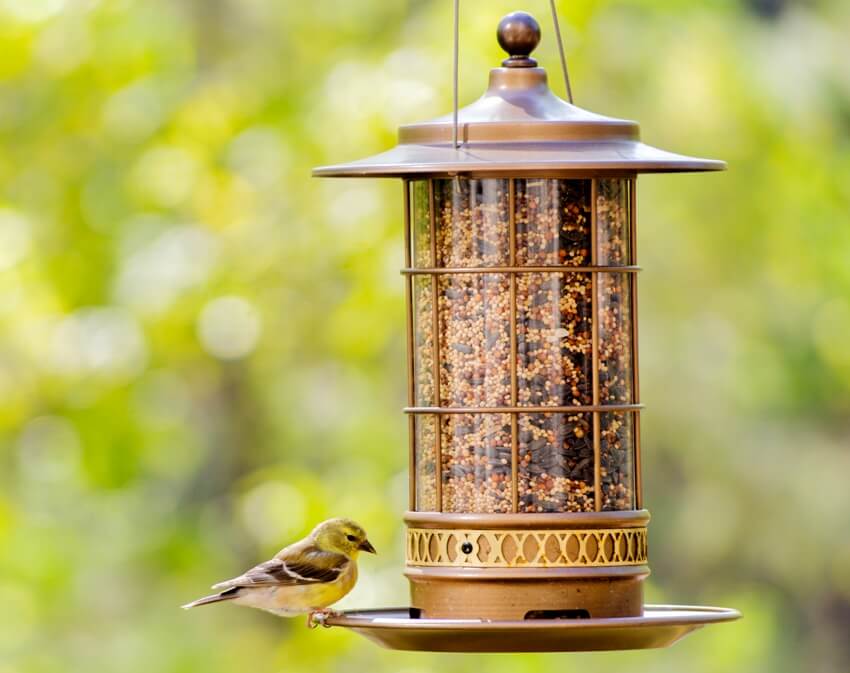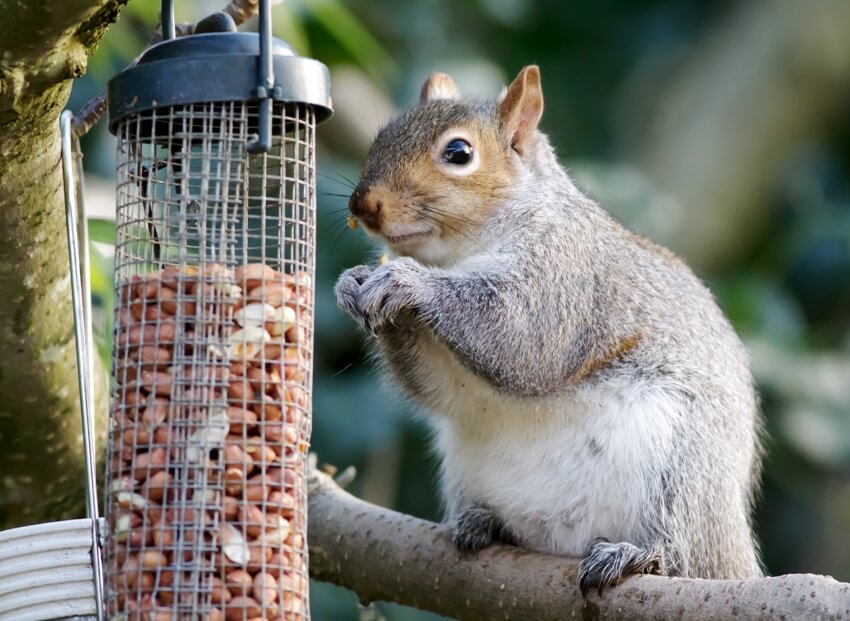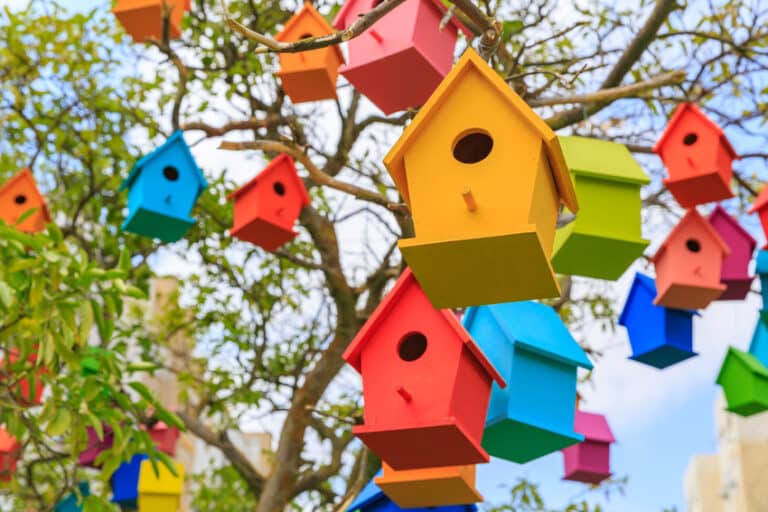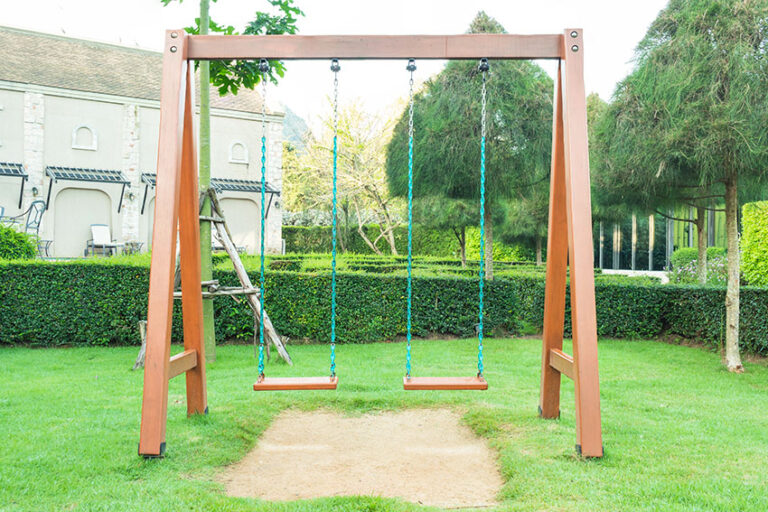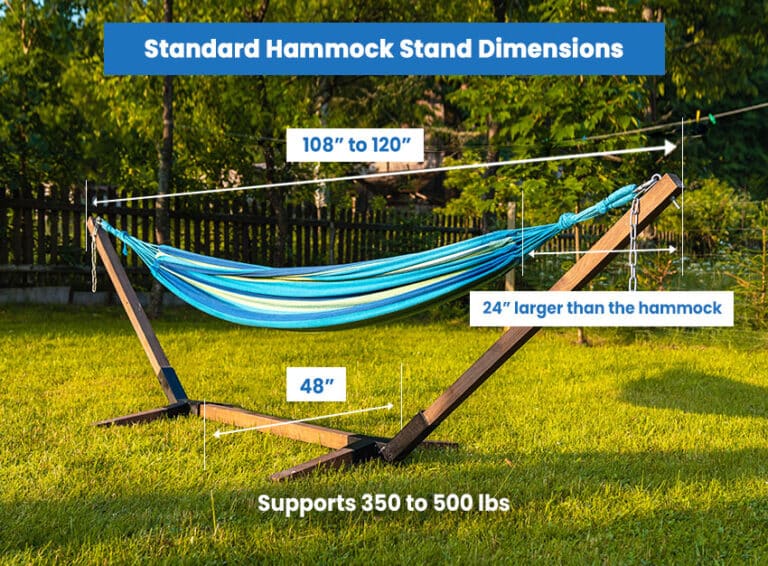Types of Bird Feeders to Attract Birds to Your Backyard
See the different types of bird feeders including ideas on how to hang and attract birds like cardinals to feeders and tips on how to keep squirrels, crows, and other animals away from bird feeders.

Maybe you’re like most of us and you’ve had the same bird feeder that belonged to your mom in your backyard for the last decade, or maybe you just spotted a bird out your window and decided to help it along by offering some pet-friendly birdfeed.
Either way, there’s always a reason to get a new bird feeder, and the moment you fill it up and hang it outside to watch the first visitor land on it is super satisfying.
Whether you’re a tiny, bird-sized camper person or a simple tub-feeder person, there’s a bird feeder that works for your bird oasis, and we’ll help you find it.
Needless to say, if you’ve ever searched for bird feeders on Pinterest, you’ve seen them all. But what about a realistic bird feeder that you’re actually up to maintaining? Sure, painted wood flowers are cute, but they’re also impossible to clean and start to look dingy after the first cold season.
Proper birdseed selection is also essential, as different birdseeds attract distinct bird species. Providing a variety of birdseeds and birdfeeds will entice more birds to visit your feeder, turning your backyard into an animal sanctuary.
Let’s get into some types of bird feeders that are both nice and functional and will attract birds and other animals year-round.
Platform Feeder
These types of bird feeders accommodate many types of visiting birds. They typically come with an open platform at the bottom, covered by an open or pergola-style roof to prevent rain and debris from landing in the seed.
According to All About Birds, platform and tray feeders “attract the widest variety of seed-eating feeder birds, including pigeons, starlings, and House Sparrows, but also grosbeaks and native sparrows.”
Although platform feeders are great for smaller birds, they may be more difficult for larger birds like cardinals who can’t land on their ledges.
Platform feeders are also not ideal for those who want to feed birds, but not squirrels; in fact, squirrels can easily access the goods in these trays, making it harder for the intended recipients to access their food.
Tube Feeder
These are a finch’s paradise. Tube feeders are wonderful for small to medium-sized feathery guests, as their pegs just below the openings allow for a nice place to sit and dig at the seed inside. Beside their ease of access, tube feeders are easy to fill and maintain, and can be easily cleaned with a bottle brush.
The only real downside to these types of bird feeders is that due to their design, they tend to attract mold if not cleaned often, especially if they’re not visited enough to need refilling.
As seed sits in these, it begins to break down and rot. However, with regular cleaning, they’re perfect for most backyard bird lovers. Check out our backyard essentials guide here.
Hopper Feeder
Hoppers are fantastic for wintertime birds due to their clever design. These feeders generally feature a middle compartment with small openings at the bottom, where seed falls into the tray much like a siphon. When selecting wildlife-friendly items like these feeders, it’s important to take price, content, and durability of the products into account.
A roof overtop of the seed allows it to keep for longer, and the tray is usually big enough to accommodate several small birds at one time.
These feeders need to be cleaned frequently, as there is little airflow into the middle chamber where the seed is stored.
Otherwise, they’re great for birdwatchers and attract a wide variety of birds throughout the United States. Before purchasing make sure to read reviews and see the questions being asked to ensure you’re getting the best feeder for your needs.
Window Feeder
Placement is key when it comes to window feeders; they need to be placed where they can be cleaned, but also away from where the main activity is in your house.
Birds won’t generally stop to feed near a busy window with lots of movement inside, but will happily perch at a feeder above a kitchen window or bathroom. Window types of bird feeders are fun and educational, and can help you snap some great photos of your feathery friends as they stop by for a snack.
Consider the types of birds you want to attract and read feeder reviews to ensure you’re getting one that is right for the birds in your area.
Hummingbird Feeder
Specifically designed for your favorite little buzzers, hummingbird feeders are important to hummingbird populations. In urban areas where concrete is more plentiful than flowers, hummingbirds need to find energy to get them through their day.
There are many hummingbird products on the market. Some don’t have a perch and their is a big debate about whether a perch is better to have or not.
I’ve tried both kinds and the ones without a perch may allow other birds to drink more easier rather than have one bird take over the spot. When they do sit its usually for a very short time (10 to 30 seconds).
A typical food solution is one part sugar to four parts water. If you buy premixed hummingbird food, avoid solutions with red dye in them, as the dye can cause burns in hummingbird’s throats, preventing them from eating and often leading to death.
Hummingbird feeders also attract wasps, so try hanging a wasp trap nearby to avoid problems and keep your feeder open to its intended visitors.
Oriole Fruit Feeder
Orioles require specific types of foods in their diets depending on the season and weather conditions. In many parts of the country, orioles can only be seen during certain times, but it helps to put out food to increase your chances of seeing one!
Oriole feeders are designed specifically for orioles, and come with a bottom feeding tray; some even come with a detachable dish for jelly and meal worms. These should be cleaned thoroughly between each use, as bacteria are quick to grow on fruit outdoors.
As you search for an oriole feeder, take into account that they are attracted to bright colors such as orange and some models can trap and kill bees who are also attracted to the nectar. to avoid bees getting trapped make sure the model you choose has a be guard attachment.
Suet Feeder
The holy grail of woodpeckers, suet feeders attract many species of woodpeckers, flickers, and other similarly-sized bird species. Suet feeders are tremendously easy to fill and clean, and are great for cooler climates where suet won’t melt in the hot sun.
Keep in mind that woodpeckers are shy, so you’ll want to place these feeders on a higher branch than most of your other types, or one on a pole so they have a chance to eat in peace.
Suet is an excellent source of food and beneficial calories for birds even during times of snow, and through the cold winter months Don’t forget to consider your location’s weather and wildlife and ease of use as you browse various suet feeder.
If you’re lucky, you can find species such as the downy woodpecker, red and yellow-breasted flickers, and more, attracted to the nectar or other supplementary products you provide!
Nyjer Finch Feeder
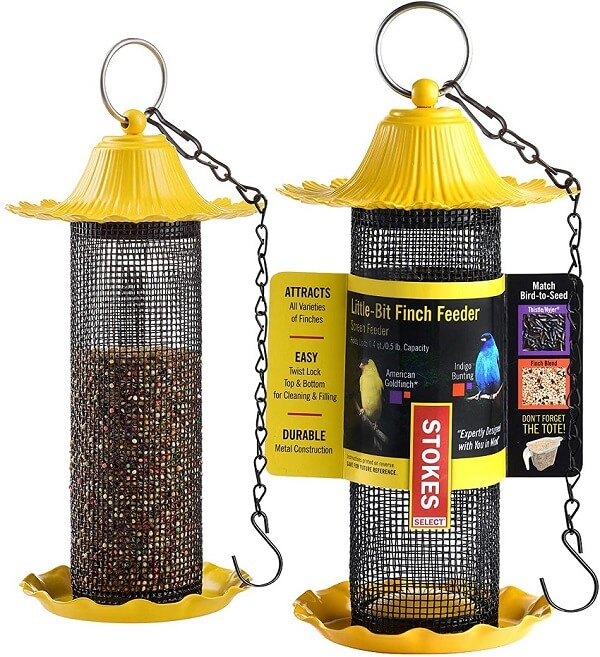
Nyjer has been making feeders specifically for finches including various size options, for as long as people have wanted to feed them. Finch feeders are designed to hold thistle seed, an important and balanced part of a finch’s diet, allowing for an enjoyable feeding experience.
Since thistle seed is so tiny, most often these products will be made of mesh screens or come in tubes that have specialized feeding ports in them that are easily accessible to finches or sparrows.
Some brands of thistle seed will sprout, however, so be sure to remove any spilled seed from the area where you fill your feeders, or use salt just underneath the feeder to keep seeds (or anything else) from sprouting there.
Peanut Feeder
For those who don’t mind giving a little to the squirrels as well as the local bird population, peanut feeders are plenty for everyone.
Great for larger bird species such as jays, crows, magpies and sometimes doves, peanut feeders are usually a wreath of spaced wire or a tube with the same material.
The spacing of the wire is just enough to allow peanuts to stay inside without falling out, and birds are able to pull them out using their beaks. Opt for unsalted peanuts to provide a hearty and nutritious meal to these birds year-round.
DIY Log Feeder
Log feeders offer a more natural feel for birds, especially those who enjoy suet. These are great for attracting wild birds and species who don’t typically frequent backyard feeders.
Aside from being natural, these feeders are also easy to make. Simply bore out a few holes around the outside of a small log, so that about a tablespoon of suet will fit inside each hole.
You can also bore holes all the way through the log, with enough room for a bird to put its head inside without getting stuck, to hold more food. Hang these on trees or fence posts to attract even more species.
How Do Birds Find Feeders?
Birds don’t have a keen sense of smell, so they primarily use their sight and instincts to find food. Birds have a good idea of what their food looks like, so once they see that a feeder is filled with delicious seed, they pinpoint where it is and will remember to come back if the food source is filled regularly.
They can also communicate with one another, so birds can share information with each other when they find food sources that can help other birds subsist.
Most of the time, unless birds such as house finches, goldfinches, nuthatches, chickadees, grosbeaks, and others are abundant in your area, it could take a few days for them to find your feeders.
If you haven’t seen any activity on your feeder or noticed the food inside depleting at all within a week, try to place the feeder where it can be easily spotted from adjacent trees and from overhead.
You should see visitors fairly quickly in suburban environments and rural areas. If you feel like you still have no visitors, including those attractive goldfinches and nuthatches, it might be time to switch to a new feeder.
Where To Hang Feeders
If you’re unsure where to place your bird feeder, opt first for a spot near trees, tall fence posts, or near water features. These areas are generally safer for birds, including chickadees and grosbeaks, among others. Avoid placing these types of bird feeders near buildings or in lower areas where the dangers of cats and other household pets can reach them.
Ideally, you’ll want to hang your feeder in the most natural part of your yard as possible, but placing near water works great for this, too. Birds need to drink and bathe, so they likely already frequent water features in your yard or near it.
You also want your feeder to be seen, so avoid placing it in dense brush or foliage. If birds like nuthatches and chickadees can’t see your feeder through the brush, they likely won’t know it’s there and continue looking for food elsewhere.
Once you have an established spot for your feeder, try not to move it; birds, including goldfinches and grosbeaks, can become accustomed to visiting the same feeders throughout seasons and will return to places they’ve been before, where they know there will be food waiting for them.
How To Attract Birds To Feeders
The best way to attract birds to your feeders is to make them feel safe and at home. Adding a bird bath or some foliage around your feeders helps to offer them more than food by providing shelter and water.
Additionally, you can leave some garden or yard debris nearby for them to spend more time in, rather than visiting feeders and then fluttering back off into the wilderness. Keeping more birds around will attract other birds, who will undoubtedly want in on the action. See what colors attract birds here.
Having a variety of foods and feeders reduces friction among various birds. – Country Wisdom Almanac: 373 Tips, Crafts, Home Improvements, Recipes, and Homemade Remedies, Editors of Storey Publishing’s Country Wisdom Bulletins
Another great tip is to keep pets like house cats and dogs who bark away from your feeder areas. When there is a threat present, birds such as goldfinches, grosbeaks, and others will stay away as much as possible to avoid being eaten or injured.
Domestic cats are one of the leading causes of decline in urban bird species, so it’s important that you keep your cat away from them as much as possible.
Try only letting them out onto an enclosed patio or keep dogs on a lead away from where your feeders are to make birds feel safer and more secure as they eat. Find out how to keep cats off outdoor furniture here.
What Type Of Feeder Attracts The Most Birds?
While there are tons of different types of bird feeders, some designed for many species and some designed only for one, hopper feeders are by far the most versatile option for feeding a wide variety of birds.
Despite needing to be cleaned often, hopper feeders accommodate birds of varying sizes, and can offer respite for birds who need a cozy place to sit and eat. Similarly, tube feeders provide a nice option for a variety of bird species, as they’re generally accessible to most species and sizes.
If neither of these types of bird feeders are in the cards for you, you can also offer a basic covered tray. These can be made out of almost anything you have laying around, and their open concept allows almost any bird the ability to fly in for a bite and rest before taking off again.
A platform works just as well, though some seed may fall off the sides, unavailable to birds in tall grass and shrubs, though seed that falls on open ground can be a treat for ground-feeding birds like pigeons and mourning doves.
How To Keep Squirrels Off Feeders
Pesky squirrels can really dampen the mood for birds wanting to eat in peace. They’re also quite stingy, and will drain your feeders dry, given the chance, in order to stock up for winter.
While some folks don’t mind sharing with squirrels, they can be disruptive. There are a few tricks for keeping squirrels out of feeders, but be warned: they will eventually find a way around your method.
The absolute best way to keep squirrels off feeders is to use a baffle. Tried and true, baffles are a surefire way to keep squirrels from dropping in on feeders from above.
If your feeders are high off the ground, this works well in preventing them from stealing seed, as they’re left with no way to access your feeders. This simple cone-shaped device offers no grips for squirrels to grab onto, and keeps them at bay while the birds happily snack away.
How To Keep Crows Off Feeders
Crows have a tendency to scare off smaller bird species, which means you won’t see many other birds around once they take over your feeders. To keep them from bullying the little guys out of their feeding spot, try to stick to feeders that are meant for smaller birds.
These will typically have smaller posts attached to them, which means there’s room for small birds, but not larger ones. Since crows can’t land on these much shorter posts, they’ll be forced to seek food elsewhere.
Another great way to keep crows out is to keep things out of your yard that attract them, or use things to attract them to other areas away from your feeders. Don’t leave trash or debris around your yard, which crows like to rummage through.
Additionally, try adding some shiny wind spinners or old compact discs to other parts of the yard; crows won’t be able to resist not checking them out, and they’ll be happily distracted by the shiny objects themselves.
What are you best bird feeder stations? Let us know your favorite bird watching tips in the comments below. Visit this page on walkway ideas designs for more outdoor spaces ideas and improvements.



